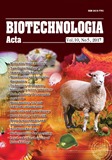ISSN 2410-7751 (Print)
ISSN 2410-776X (Online)

"Biotechnologia Acta" V. 10, No 5, 2017
https://doi.org/10.15407/biotech10.05.051
Р. 51-62, Bibliography 20, English
Universal Decimal Classification: 544.7:547.458.233.32:544.032.733:664.127.7
Turov V.V., Krupska T.V., Golovan А.P., Кartel М.Т.
Chuiko Institute of Surface Chemistry of National Academy of Sciences of Ukraine, Kiev
The state of water in the hydrated sucrose powder, in its melt, and composite systems containing 3 parts of silica (A-300 or AM1) and 1 part of sucrose in air, low-polar organic solvent-deuterochloroform and CDCl3 medium with addition of strong acids has been studied by low-temperature 1H NMR spectroscopy. It was demonstrated that at the joint mechanoactivation of sucrose with nano-silica, its amorphization takes place. In this case, the adsorption of water in such a composite is not accompanied by the dissolution process in interfacial water of the sucrose immobilized on the SiO2 surface. It was found that the effect of sucrose solubility increasing accompanies the placement of the composite in a medium that does not dissolve water and sucrose, an organic solvent - deuterochloroform. It was suggested that it is due to an increase the contact area of adsorbed water clusters with the sucrose surface. The maximal concentration of sucrose, which dissolves in interfacial water, is about 30% by weight. The replacement of hydrophilic silica (A-300) by hydrophobic silica (AM1), while maintaining the concentration ratio of components and the amount of adsorbed water, reduces the free energy of water binding in the composite system. The obtained regularities can be used in the design of a new generation of enterosorbents.
Keywords: low-temperature 1H NMR spectroscopy, sucrose, hydrodensed, hydrophilic and hydrophobic silica; composite system.
© Palladin Institute of Biochemistry of National Academy of Sciences of Ukraine, 2017
References
1. Medical Chemistry and Clinical Application of Silica (Eds. A. A. Chuiko). Kyiv: Naukova
dumka, 2003. (In Russian).
2. FAO/WHO Codex Alimentarius Commission 1973. List of additives evaluated for their safety-in-use in food. First series. CAC/FAL 1-1973.
3. Tarasevich Ju. I. Surface energy of oxides and silicates.Teoret. eksperim. khim. 2006, 42(3), 133–149. (In Russian).
4. Mironyuk I. F., Gun’ko V. M., Turov V. V., Zarko V. I., Leboda R., Skubiszewska-Zi?ba J. Characterization of fumed silicas and their interaction with water and dissolved proteins. Colloids Surf. A. 2001, 180(1–2), 87–101. https://doi.org/10.1016/S0927-7757(00)00764-0
5. Gun’ko V. M., Mironyuk I. F., Zarko V. I., Voronin E. F., Turov V. V.Morphology and surface properties of fumed silicas. J. Colloid Interf. Sci. 2005, 289(2), 427–445. doi: 10.1016/j.jcis.2005.05.051
6. Blitz J. P., Gun’ko V. M. (Ed.) Surface Chemistry in Biomedical and Environmental Science. NATO Sc. Series II: Mathem. Phys. Chem. V. 228, Dordrecht: Springer, 2006. 444 p. https://doi.org/10.1007/1-4020-4741-X
7. Zarko V. I., Andrijko L. S., Gun’ko V. M., Malysheva M. L., Gackij A. A., Gerashchenko I. I. Structural-absorption characteristics of pyrogenic nanooxides of silica, alumotita nosilicates modified with polyvinyl alcohol and polyethylene glycol. Himija, fizika i tehnologija poverhnosti.
2006, V. 11, 225–244. (In Russian).
8. Turov V. V., Gun’ko V. M. Clustered water and ways to use it. K.: Naukova dumka, 2011, 313 p. (In Russian).
9. Smirnov A. N., Markova L. I., Pchelinceva N. V., Krylatova Ja. G., Kosyreva I. V. The main classes of organic compounds. Part IV. Carbohydrates. Saratov: Izd-vo, 2010, 59 p. (In Russian).
10. Georgієvs’kij V. P. State Formology of Ukraine. Farmacevtichna enciklopedіja. (In Ukrainian).
11. Gerashchenko І. І. Enterosorbents: Drugs and dietary supplements. Kyiv: Vydavnytstvo Іnstytutu khіmіi poverkhnі NAN Ukraini, 2014, 248 p. (In Ukrainian).
12. Turov V. V., Gun’ko V. M., Turova A. A., Morozova L. P., Voronin E. F. Interfacial behavior of concentrated HCl solution and water clustered at a surface of nanosilica in weakly polar solvents media. Colloids Surf. A: Physicochem. Eng. Asp. 2011, 390(1), 48–55. https://doi.org/10.1016/j.colsurfa.2011.08.053.
13. Gun’ko V. M., Turov V. V., Turov A. V. Hydrogen peroxide — water mixture bound to nanostructured silica. Chem. Phys. Lett. 2012, V. 531, P. 132–137. https://doi.org/10.1016/j.cplett.2012.01.090
14. Gun’ko V. M., Morozova L. P., Turova A. A., Turov A. V., Gaishun V. E., Bogatyrev V. M.,
Turov V. V. Hydrated phosphorus oxyacid alone and adsorbed on nanosilica. J. Colloid. Interface Sci. 2012, V. 368. P. 263–272. doi: 10.1016/j.jcis.2011.11.018.
15. Gun’ko V. M., Turov V. V. Nuclear Magnetic Resonance Studies of Interfacial Phenomena. New York: Taylor & Francis, 2013, 1070 p. https://doi.org/10.1201/b14202
16. Gun’ko V. M., Turov V. V., Bogatyrev V. M., Zarko V. I., Leboda R., Goncharuk E. V., Novza A. A., Turov A. V., Chuiko A. A. Unusual Properties of Water at Hydrophilic/Hydrophobic Interfaces. Adv. Colloid Interface Sci. 2005, V. 118, P. 125–172. https://doi.org/10.1016/j.cis.2005.07.003
17. Aksnes D. W., Kimtys L. Characterization of mesoporous solids by 1H NMR. Solid State Nucl. Magn. Reson. 2004, V. 25, P. 146–163. https://doi.org/10.1016/j.ssnmr.2003.03.001
18. Petrov O. V., Furo I. NMR cryoporometry: Principles, application and potential. Progr. In NMR. 2009, 54(2), 97–122.
19. Krupska T. V., Turov V. V., Barvіnchenko V. N., Filatova K. O., Suvorova L. A., Kartel M. T.
Method for compressing silica. Ukraine Patent No105151. March 10, 2016. (In Ukrainian).
20. Thermodynamic properties of infundible substances. Ed. V. P. Glushko, M.: Nauka. 1978, 495 p. (In Russian).

